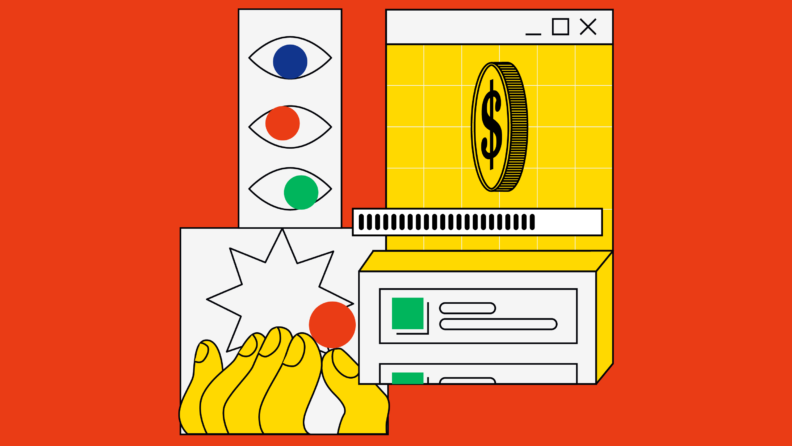The average enterprise manages nearly 350 terabytes of data. Imagine what you’d do if you had to hire people to comb through that data by hand—you’d probably go out of business. Fortunately, business intelligence can help with just that.
In fact, we found 11 business intelligence examples where major companies used insightful BI tools to save time, reduce costs, and increase customer satisfaction, giving you all the inspiration you need to adopt your own BI system and strategy.
What Is Business Intelligence?
Business intelligence comes from data, so business intelligence software helps people and companies make better decisions. Each software uses data visualization, data mining, and other techniques to take large data sets and make them more manageable.
If you had to manually review every piece of data collected by your company, your eyes would probably glaze over after about an hour. Business and sales intelligence enables decision making by presenting complex data in charts, graphs, dashboards, reports, and other easy-to-read materials.
Here’s why business intelligence is so important:
- This type of software is like your own personal Sherlock Holmes. It digs through thousands of data points to uncover customer trends and help you better understand customer behavior. As a result, business intelligence tools help you deliver more personalized experiences.
- With business intelligence, it’s possible to identify your most successful products and services, giving you the opportunity to direct more resources where needed.
- BI software eliminates the need to calculate important business metrics by hand. With just a glance at a dashboard, you’ll know exactly where your business stands.
Who Uses Business Intelligence?
Almost anyone can benefit from using business intelligence, but BI software is more common in some departments than others. For example, finance managers use business intelligence to keep tabs on a company’s profitability. It also helps finance professionals identify concerning trends in revenue generation and spending.
Marketing professionals rely heavily on BI software, as they need to understand customer behavior and make business decisions accordingly. BI tools also make it easier for marketers to track key metrics in real time, giving them more opportunities to adjust their campaigns.
Operations managers use business intelligence to increase efficiency. For example, the reports produced by BI software can help an operations professional identify production bottlenecks or logistical problems. Once a company is aware of those problems, it can use business intelligence to model the potential outcome of each proposed solution.
Sales teams also use business intelligence tools, as BI makes it possible to determine how profitable each customer is, how much money customers spend per transaction, and how customers respond to promotions. Sales managers benefit from using BI tools to track team performance and determine if their salespeople are meeting their goals.
Real-World Examples of Business Intelligence In Use
Still not convinced about the value of business intelligence? Check out these use cases:
1. Coca-Cola Maximizing Operational Efficiency
In 2010, Coca-Cola had 74 bottlers, all with different ways of collecting and distributing data. It just wasn’t possible to manually enter that data into a single database, making it more difficult for Coca-Cola employees to create accurate sales reports, identify problems with the supply chain, and determine how many units to produce to meet customer demand.
To solve these problems, the company directed its bottlers to stop using their legacy systems. Coca-Cola invested in a robust business intelligence solution, creating a single source of truth about the business. The decision increased efficiency significantly, as it saved 6 weeks’ worth of manual processing each year. Implementing BI software also reduced the risk of human error and helped Coca-Cola save money.
2. Starbucks Predicting Purchases & Customizing Offers
Starbucks is known for having a cult-like following, with customers lining up around the block to grab a coffee or try one of the company’s bakery items. You can get a cup of coffee almost anywhere, so why does Starbucks have so many raving fans? Because it uses business intelligence tools to predict purchases and customize offers.
The company relies on several data sources, making it extremely important to have a unified system capable of producing detailed reports and dashboards. When Starbucks launched its mobile app, it started collecting even more data, making it easier to identify trends and predict future behavior. Business intelligence allows Starbucks executives to better understand the following:
- Which stores are the most profitable
- What products customers enjoy the most
- When customers tend to make the most purchases
- How holidays and other seasonal events affect sales
Starbucks uses this information to create a personalized experience for every customer who uses the app. For example, if a customer usually buys a cup of coffee, they might see a promotion on bags of coffee grounds. This is an easy way for Starbucks to increase its sales.
The Starbucks app even makes product recommendations based on the weather. If it’s hot outside, the app might suggest a refreshing cold brew to help the customer cool down. These personalized recommendations have paid off, with the company reporting a 7% increase in comparable global store sales in 2022.
3. Netflix Suggesting What to Watch Next
One reason Netflix is so successful is because its executives understand the importance of data analysis. They don’t just collect data and let it sit there—they use it to make better business decisions. As a result, the company has a high customer retention rate compared to similar streaming services.
Netflix collects many data points, such as what movies you watch, when you watch them, and whether you finish a movie or stop watching at the halfway point. It uses this information to make personalized recommendations for every customer. If you love crime dramas, there’s a good chance the streaming service has suggested you watch Criminal Minds, How to Get Away with Murder, or Good Girls at least once.
Netflix also uses data to automate certain processes. Without business intelligence, it would be difficult to determine if a show should be renewed or canceled. Instead of making decisions based on gut feelings, executives use business intelligence tools to determine when a show is profitable and when it’s costing the company more than it’s worth. As a result of using business intelligence from the very beginning, Netflix now has a market cap of more than $143 billion.
4. Chipotle Creating a Unified View of Restaurant Ops
Chipotle is known for its guacamole and overfilled burrito bowls, but the company also has a reputation for using business analytics effectively. With more than 3,000 restaurants around the world, it would be a disaster if the corporate office tried to collect data from a smattering of legacy systems. By the time someone finished entering the data manually, it would be outdated, making it impossible to make data-driven decisions.
Chipotle solved this problem by implementing a single business intelligence system. This BI solution offers access to standardized reports, ensuring that everyone is on the same page when it’s time to make decisions about opening new restaurants, creating menu items, or switching suppliers. Business users also have access to standardized reports, saving them thousands of hours each year.
5. Uber Implementing Surge Pricing
Uber relies heavily on data analytics to make critical business decisions. One example is the practice of surge pricing, which tries to balance supply with demand, reducing ride wait times and increasing the company’s revenue.
To make surge pricing work, Uber uses artificial intelligence to analyze supply and demand data. If demand increases due to poor weather or a special event, the app activates surge pricing in that area. When surge pricing is in effect, customers can either pay more for the service or wait until it’s less busy. Therefore, the predictive capabilities of AI make it possible to deliver a customized experience.
6. Delta Recognizing Valued Frequent Fliers
Data doesn’t do you any good if it’s just sitting in a data warehouse. You need to be able to move past raw data and gain actionable insights. That’s exactly how Delta has been able to provide better customer service over the past few years.
If you travel frequently, you may have noticed that Delta flight attendants sometimes greet you by name once you’re settled in your seat. This is because the airline’s self-service BI system provides information about valued customers. Executives know that greeting someone by name and attending to their needs is a great way to improve the customer experience, increasing trust and loyalty.
Delta’s business intelligence system also keeps track of customers who participate in the Delta SkyMiles program, allowing employees to better understand key aspects of business operations. For example, BI tools make it easier to track KPIs and determine when to make critical business changes.
7. REI Increasing Membership Sign-Ups
REI follows a co-op model, allowing customers to become members in exchange for special event pricing and discounts on high-quality outdoor gear. The more memberships REI sells, the more revenue it generates, making member sign-ups an important aspect of the business.
According to a case study published by Tableau, REI has been using business intelligence, machine learning, and other technologies to improve its business performance. The company made the shift from Excel to Tableau, giving employees access to additional forecasting tools and a better ability to identify market trends.
With its new business intelligence system, REI drives member sign-ups by analyzing customer acquisition and retention metrics. Company employees also monitor customer counts, customer lifetime value, and price per item. This allows them to streamline business processes and do a better job meeting each customer’s needs.
8. New York Shipping Exchange Centralizing Real-Time Data
New York Shipping Exchange is always on the lookout for ways to increase efficiency. That’s why company executives decided to stop relying on manual processes and start using a BI platform to uncover critical business insights.
When the company first opened, employees manually extracted data from multiple applications and then entered that data into Excel for analysis. Not every employee had the same level of access, making it difficult to complete the import process in a timely manner. The engineering team was bogged down by requests for assistance with big data, wasting a substantial amount of time that could be spent on other responsibilities.
Eventually, executives could no longer ignore this inefficient process. The company adopted a BI system, making it possible to collect large amounts of business data in one place. BI now helps New York Shipping Exchange use data more effectively.
9. Reddit Eliminating a Data Bottleneck
Reddit has hundreds of millions of visitors every month. It would be impossible to track those visitors manually, so the company uses a variety of business intelligence and analytics tools to increase efficiency. Before Reddit started using its current BI system, employees wasted a lot of time trying to handle data-related requests and make sense of all the data collected by the website.
Company leaders solved this problem by adopting Chartio, a BI tool that makes it possible to quickly analyze large amounts of data and identify current trends. For example, Chartio allows Reddit to determine which products are getting a lot of attention from users, making it easier to generate ad revenue.
10. Expedia Building Customer Satisfaction
Customer satisfaction is one of the keys to business success, which is why Expedia decided to stop using manual processes and implement a robust business intelligence system. Initially, employees spent so much time collecting data that they didn’t really have time to analyze it, leaving Expedia scrambling to understand customers’ needs.
Now that the company is using BI, employees have access to essential KPIs and objectives, allowing them to track performance in real time. Dashboards, reports, and other tools also make it possible to create personalized offerings, increasing customer satisfaction and helping Expedia build loyal relationships.
11. American Express Developing New Products
Developing new products allows American Express to attract new customers, increasing revenue and giving investors a better return on their funds. When the company relied on manual processes, it didn’t have much insight into what products customers wanted. Now that American Express is using business intelligence, however, employees can use the vast amount of data at their disposal to make better decisions.
As a result, the company now has a large portfolio of products, from the traditional charge card to secured cards for customers who need help building their credit profiles. Business intelligence makes it easier to identify current trends, gain insight into customers’ needs, and develop products that are likely to be well-received.
Need expert help selecting the right Business Intelligence (BI) Software?
We’ve joined up with Crozdesk.com to give all our readers (yes, you!) access to Crozdesk’s software advisors. Just use the form below to share your needs, and they will contact you at no cost or commitment. You will then be matched and connected to a shortlist of vendors that best fit your company, and you can access exclusive software discounts!
Want To Learn Even More About Business Intelligence?
Check out our ultimate guide to BI, learn how to design a smart BI dashboard, and start building your own successful business intelligence strategy. While you're here, be sure to sign up for The RevOps Team's newsletter to stay atop of the latest tips.




